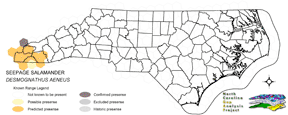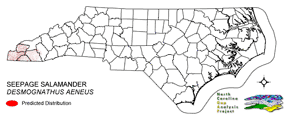
| Taxa: |
| Order: |
| Family: |
| Amphibia |
| Caudata |
| Plethodontidae |
| NatureServe Global Rank: |
| NatureServe State (NC) Rank: |
| G3G4 |
| S3 |
| Federal Status: |
| NC State Status: |
| FSC |
| SR |


| Land Unit |
| US Fish & Wildlife Service |
| US Forest Service |
| US National Park Service |
| US Department of Defense |
| NC State Parks |
| NC University System |
| NC Wildlife Res. Com. |
| NC Forest Service |
| NC Div. of Coastal Mgmt. |
| Local Governments |
| Non-Governmental Org. |
| Other Public Lands |
| Private Lands |
| GAP Status 1-2 |
| All Protected Lands |
| Statewide |
| Hectares |
| 0.00 |
| 24,515.01 |
| 18.09 |
| 1,328.76 |
| 0.00 |
| 0.00 |
| 0.00 |
| 0.00 |
| 0.00 |
| 0.00 |
| 2.25 |
| 0.00 |
| 32,617.53 |
| 2,724.39 |
| 25,846.02 |
| 58,481.64 |
| Acres |
| 0.00 |
| 60,577.90 |
| 44.70 |
| 3,283.44 |
| 0.00 |
| 0.00 |
| 0.00 |
| 0.00 |
| 0.00 |
| 0.00 |
| 5.56 |
| 0.00 |
| 80,599.66 |
| 6,732.11 |
| 63,866.89 |
| 144,511.25 |
| % of Dist. on |
| Prot. Lands |
| 0.0 % |
| 94.9 % |
| 0.0 % |
| 5.1 % |
| 0.0 % |
| 0.0 % |
| 0.0 % |
| 0.0 % |
| 0.0 % |
| < 0.1 % |
| < 0.1 % |
| 0.0 % |
| 0.0 % |
| 10.5 % |
| ----- |
| ----- |
| % of Dist. on |
| All Lands |
| 0.0 % |
| 41.9 % |
| < 0.1 % |
| 2.3 % |
| 0.0 % |
| 0.0 % |
| 0.0 % |
| 0.0 % |
| 0.0 % |
| 0.0 % |
| < 0.1 % |
| 0.0 % |
| 55.8 % |
| 4.7 % |
| ----- |
| ----- |
|
In North Carolina, largely restricted to areas southwest of the Little Tennessee River at elevations below 4400 ft (Martof et al. 1980, Petranka 1998). Found in hardwood forests under moss mats, logs or other objects, and leaf litter near creeks, springs and seepages (Martof et al. 1980, Petranka 1998). NATURE SERVE GLOBAL HABITAT COMMENTS: Beneath leaf litter or surface debris on floor of mixed hardwood forests near small creeks, springs, and seepage areas. Also occurs in damp shaded ravines. Eggs are laid under moss or in small protected depressions. |
| Code | Name | Description | NC Natural Heritage Program Equivalent |
| 230 | Piedmont Mesic Forest | American Beech - Red Oak - White Oak Forests. | Mesic Mixed Hardwood |
| 384 | Piedmont/Mountain Mixed Bottomland Hardwood Forests | Includes temporarily to seasonally forests dominated by hardwood species. Hardwoods include sweetgum, red maple, sycamore which co-occur in a mosaic of bottomland and levee positions. Includes alluvial hardwood forests in the mountains. Hemlock and white pine may occur as inclusions, but are generally mapped separately. | Piedmont/Mountain Alluvial Forest, Piedmont/Mountain Levee Forest |
| 228 | Piedmont Dry-Mesic Oak and Hardwood Forests | Primarily oak dominated forests, white oak is often dominant, with co-dominants including . Also represented by sweetgum and tulip poplar dominated forests. | Dry Mesic Oak Hickory Forest, Basic Oak Hickory Forest, Dry Oak Hickory Forest |
| 517 | Hemlock Floodplain Forest | Alluvial forest with hemlock and/or white pine in mountains and western piedmont. Hydrology is generally temporarily to seasonally flooded. | Canada Hemlock Forest |
| 522 | Northern Hardwoods | High Elevation forests including yellow birch, American beech, and yellow buckeye. Includes forests with Hemlock and Yellow Birch. | Northern Hardwoods Forest, Boulderfield Forest |
| 525 | Appalachian Oak Forest | A variety of oak forest types including Black, White, Scarlet Oaks in dry to mesic situations. Includes forests historically co-dominated by American Chestnut. | High Elevation Red Oak Forest, Montane White Oak Forest |
| 526 | Appalachian Cove Forest | Mixed Mesophytic forests of the mountains. Includes tuliptree, basswood, yellow buckeye and surgar maple. This class is mapped to include cove forests dominated or co-dominated by hemlock. | Rich Cove Forest, Acidic Cove Forest |
| 527 | Appalachian Hemlock | Upland hemlock forests of the moutains region. Vary from side slopes to steep slope positions. | Canada Hemlock Forest |
|
Hairston, N. G., Sr., and R. H. Wiley. 1993. No decline in salamander (Amphibia:Caudata) populations:a twenty-year study in the southern Aplachians. Brimleyana 18:59-64.
Folkerts, G. W. 1968. The genus DESMOGNATHUS Baird (Amphibia:Plethodontidae) in Alabama. Ph.D. diss., Auburn Univ., Auburn, Alabama. 129 pp. Harrison, J. R. 1992. DESMOGNATHUS AENEUS. Cat. Am. Amph. Rept. 534.1-534.4. Petranka, J. W. 1998. Salamanders of the United States and Canada. Washington DC: Smithsonian Inst. Press. Mount, R. H. 1975. The Reptiles and Amphibians of Alabama. Auburn University Agricultural Experiment Station, Auburn, Alabama. vii + 347 pp. Behler, J. L., and F. W. King. 1979. The Audubon Society field guide to North American reptiles and amphibians. Alfred A. Knopf, New York. 719 pp. Martof, B. S., W. M. Palmer, J. R. Bailey, and J. R. Harrison, III. 1980. Amphibians and reptiles of the Carolinas and Virginia. University of North Carolina Press, Chapel Hill, North Carolina. 264 pp. |
For more information please contact them at:
NC-GAP Analysis Project
Dept. of Zoology, NCSU
Campus Box 7617
Raleigh, NC 27695-7617
(919) 513-2853
www.basic.ncsu.edu/ncgap